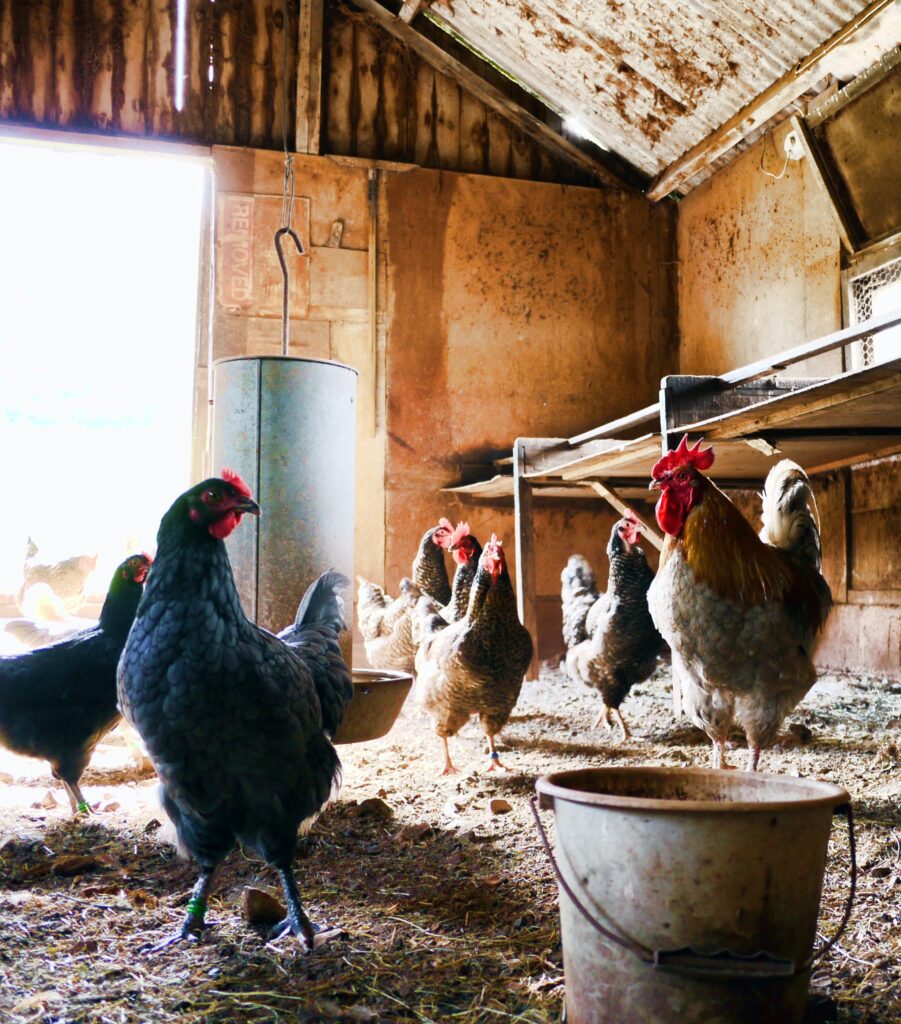Raising chickens can be one of the most rewarding experiences on your farm or homestead. Farm-to-table food is something that I have so much passion for. But not only do chickens offer eggs – they’ll eat pests that might otherwise harm your garden plants. Plus, they are so entertaining to watch. Chickens can be raised for meat, eggs, or sometimes both, but raising for eggs is the most common, and that’s what I’m going to talk about here. Keep on reading if you want to learn more about raising chickens for beginners!

Why Keep Chickens?
I will always preach about how important it is to know how your food was raised. You will feed and care for them how you think is best, and there will be no mystery surrounding what you’re eating in comparison to supermarket eggs. Plus, they are fairly easy to care for once you get the hang of things. If I can do it, so can you!
Before you begin, make sure you do lots of research. Just because your grandparents, parents, or Uncle Bob from down the road had chickens doesn’t mean you can skip educating yourself. Do the research and invest in some resources – it’ll go a long way. I’ve listed a few resources toward the end of this post.
[convertful id=”220543″]
How Many Chickens Should You Get?
Chickens are social animals, so getting one or two is not recommended, but I also don’t recommend going out and buying dozens of chicks as a beginner. Six birds are a good start. On average, an adult hen will lay 2-3 eggs every three days. Hens are most productive in the first 2 years. Once production slows, a new hen population will need to be considered. There are numerous options for ‘spent’ hens; you’ll need to do your research on what option suits you best.
Gardening & Chickens
Most folks who keep chickens do so for a fresh egg supply. But chickens also work wonders in the garden! Once the garden harvest has wrapped up for the year, release the chickens, and they’ll dig up weed roots, weed seeds, insects, and any left-behind vegetables. All of the pecking and scratching that the chickens are doing is also going to mix and fluff up the soil!
Breeds
There are numerous breeds of chickens, so choosing which ones to start with can be a little overwhelming. Chicken breeds vary widely and are specifically developed for different purposes such as egg production, meat yield, or just as a fuzzy companion. When considering breeds for egg-laying, it’s important to choose those well-suited for conditions that match your area. If you live in a climate with cold, harsh winters, a breed such as Orpingtons may not be for you – unless you have properly heated shelter. Medium to large breeds tend to fare better in colder winters; smaller breeds like Silkies may not do well, although I’ve had no issues with these guys and the cold. Additionally, a calm temperament may be desirable if you have young children.
| Silkie: | Silkies are known for their soft and fluffy appearance. They only weigh about 2.5-2.5 pounds overall. Some cultures believed that Silkie chickens had medicinal properties above all other breeds. Silkies will be a good breed for you if you are prepared to keep them warm and dry year-round and if you’re limited on space and won’t be letting your girls free-range much. I’ve been told that Silkies make amazing ‘mother hens’ (pun intended) and that the sole purpose for these chickens was to be mothers. Silkies aren’t productive egg layers. Often, they’ll only produce about 100 eggs a year, and they won’t produce at all if the weather gets too hot. The eggs that Silkies produce are a beautiful creamy brown color! |
| Leghorn: | The Leghorn chicken is one of the most resourceful breeds, finding most of its food if left to free-range. She’ll lay up to 300+ eggs a year, making these hens the top bird in America for egg production. Leghorns have been bred to lay, not brood, so these girls won’t go broody. Leghorns can get quite nervous and flighty, so be cautious when letting kids near. |
| Wyandotte: | Wyandottes were bred in the 1800s to withstand the cold months. These are the perfect bird if you’re looking for a good layer that’s not too fussy. Water, quality feed, and good shelter are all she needs. If you allow your chickens to free-range, Wyandottes are great for pest management around the yard. Be careful though, as these girls aren’t the most loving chickens you’ll have in your flock. These beautiful patterned birds will lay up to 4 creamy brown eggs a week – once they reach about 20 weeks old. They come in a variety of colors and weigh around 6 pounds on average. |
| Rhode Island Red: | Rhode Island Reds have been bred over time to be excellent egg layers, though they once were a dual-purpose (meat and eggs) chicken. The eggs produced will be a shade of brown and be heavier than the average grocery store egg. They are very cold-hardy and can withstand temperature fluctuations. Rhode Island Reds don’t need special dietary requirements. These chickens will be around 6 and a half pounds once full-grown. |
| Orpington: | These guys were considered endangered for a while, but due to more and more people choosing to raise Orpingtons in their coops, they have made a comeback. They come in a variety of colors and are known as one of the friendlier breeds. These girls need to be given ample dry space as their feathers are quite dense and can remain wet for quite some time. They also need ample shade as it’s quite often that Orpingtons will succumb to the heat. They are good egg producers and can lay up to 280 eggs a year (200 on average). |
| Ameraucana: | These girls are one of the more popular breeds in America. They are known to lay around 200 eggs per year if they have adequate living conditions. They’re best known for the beautiful pale blue/green colored eggs they produce. They are many variations and colors for this bird and they make beautiful, colorful flocks. These winter hardy hens commonly grow to be around 5 1/2 pounds. Ameraucana hens are known to be quite skidding and fearful so be mindful when choosing other laying chicken species to join the flock. |


I do recommend that you do more breed research if you’ve never raised chickens before, as well as invest in a quality coop. Now, just because I say quality, I don’t mean expensive. I would even recommend starting off with a small affordable coop and work up from there. Consider your climate, the needs for whichever breed you choose, and the space when choosing a chicken coop – you don’t want to overcrowd the space with chickens. Hens need around 8 inches of roosting space each, one nesting box per 4 chickens, and around 4 square feet per chicken of overall space. I have had a decent experience with one small ‘back-yard’ coop from Amazon – I’ll link it below. If you’re looking for something bigger, I recommend buying a plan and building it yourself. Purchasing a chicken coop kit from a farm supply company is another option.
Some things to consider before purchasing chickens:
- Chickens are going to be less maintenance than you anticipate. It’s not like owning horses, cows or even dogs. The daily ‘chicken chores’ should only take approximately 15 minutes to complete.
- Start up costs can get expensive. You’ll need to invest in the chicks, the coop, waterers, feed/feeders, and whatever else you may need for your climate (ex. coop heater). The average grown hen will eat about 0.3 pounds of feed per day, and that’ll add up quickly if you have a large flock.
- This is a commitment. Its important to do your research and set yourself up for success. Although chickens aren’t a lot of work – they’re still work.
- Not all chicken breeds are the same. As I mentioned above… each breed has different temperament, diet, and laying capabilities.
- Depending on where you live, you may need to check with your town or city office to confirm that a backyard coop is allowed. If you’re rural and in the middle of nowhere like me – you have nothing to worry about.
I always want to encourage everyone to be more sustainable in everyday life but I also encourage education. To best set yourself up for success on a homestead, you’ll need to do research. I’m not saying you won’t have failures – the best lessons are sometimes failures – but being educated, lets you understand why you’ve failed, what went wrong, and what to do to fix it. I’ve included some books below that I personally own and would recommend for anyone new to the world of chickens.









